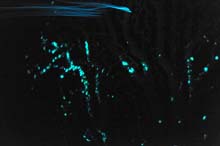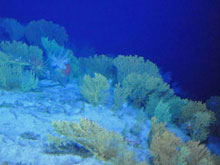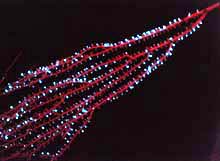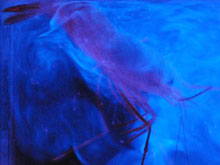
Figure 1. Bioluminescent plankton (top of image) streaks past a fluorescent coral. Click image for larger view and image credit.
Imaging Light in the Dark
July 28, 2009
Sönke Johnsen, PhDDuke University
“In the end, everything turns into work.” My father often said this, and I was reminded of it this morning while watching Don Liberatore, the submersible pilot, try for the fifth time to catch a swimming crab while at the same time preventing the other crabs from escaping. These were exactly the crabs that my colleague Tammy Frank needed for her ultraviolet (UV) vision studies, but catching a small swimming animal with a submersible is like catching an earthworm with a school bus. In the end, four of the five crabs we caught — after over an hour of effort — escaped their light-tight black box. They were still in the larger, clear box, leaving me to watch helplessly as they went blind when we reached the bright sunlight of the surface.
Don’t get me wrong. I love my job. I work with amazing people and get to see things few people ever will. Almost every morning, I wake up shocked by my good fortune. However, it is hard work. It’s often said that we know more about the surface of the moon than the bottom of the ocean. I used to believe that this showed our misplaced priorities, but, after more than a decade of oceanic research, I’ve changed my mind. Yes, the moon is far away, but in all other ways, the deep sea is harder to study. The pressure, corrosive salt water, and above all the limited visibility have us literally poking around in the dark.
In my case, I’ve spent almost every waking hour of the last 10 days either underwater, getting ready to go underwater, cleaning up, or looking at what we caught — and I have still only cracked the surface of my aspect of this expedition. My goal is to get a better understanding of the bioluminescence at the sea floor. A great deal is known about bioluminescence in plankton. We know it is common (almost universal), generally blue, and serves a range of functions. However, far less is known about benthic (on or near the sea bottom) bioluminescence. So, along with Steve Haddock, it was my job to photograph bioluminescent animals in the benthic environment and measure their spectra.
I took some pictures of bioluminescence from inside the submersible using a low-light camera, but quickly learned that photos of collected animals turned out far better. The trick, though, was to figure out which animals to collect. There are dozens of species on the sea floor in even the bleakest habitat and, unlike the case for plankton, it seems that only a small fraction of them make light. We obviously can’t collect everything, so I looked for species we hadn’t tried yet, species related to ones that we just discovered make light (mostly anemones and corals), and species that gave me a good feeling (guessed wrong on just about all of those). Sometimes, I would ask the pilot to turn out all the lights and give an animal a light whack. If it glowed, we took a sample.

Figure 2. Searching the benthic habitat for bioluminescent animals. Click image for larger view and image credit.
Once back on board the ship, we would all sit in the dark with the samples for about 10 minutes and "dark-adapt." It was suggested that we come up with a song to pass the time, but usually we just told jokes and griped about how long ten minutes is when you’re sitting in a small, dark room with 10 colleagues waiting for your eyes to adjust. Then we would gently touch the animals and see which ones lit up, hoping none of them would turn out to be poisonous.
Conveniently, almost all bioluminescent animals glow if you disturb them. The ones that did glow were taken upstairs to a dark room. (Picture the back end of a tractor-trailer strapped to the deck of a ship with all of its openings covered with black plastic.) We would then dark-adapt again, while we set up the low-light cameras and spectrometer.
We generally measured spectra first. A spectrum is essentially a "numerical rainbow." It’s a measurement that tells you how much light there is of each color. For example, a spectrum of the blue sky shows that there there’s a lot of blue light, with less green light and even less orange, yellow, and red light. The instruments that measure spectra take the light and first shine it on a diffraction grating. This is a shiny surface with many parallel grooves in it, just like a CD-ROM. And just like a CD-ROM, these grooves split up the light into its colors. Once separated into colors, the light then shines on a row of tiny light meters, each one measuring how much light there is for that color.
Measuring spectra is usually straightforward. It becomes harder to measure when the light is dim and blinking on and off. It usually takes three people: one runs the spectrometer, one touches the animal, and one holds the probe that collects the light. The probe has to be less that one millimeter from a fairly bright glowing spot for this to work. Also, the person running the spectrometer has to push a button at just the moment when the spectrum is the brightest. All this is done in the pitch dark, so you don’t know the location of the animal, probe, or the other two people. If you’re running the probe, invariably the brightest pulse of light happens right when the person running computer says that it just locked up.
Also some of the crabs pinch and some of the anemones sting. So there’s a lot of yelling. None of this is helped by the fact that we have to close the air conditioner vent (which lets in light), leaving the room to slowly roast in the Bahamian sun. It’s a good thing we’re all friends. The photography goes much the same way, with one person touching the animal and the other ready with the shutter. It usually takes about 30 tries to get a half-decent picture. All in all, getting a good spectrum and photograph of a few animals can easily take over an hour.
So what have we learned so far? First, that benthic bioluminescence is rarer than we expected. It's mostly found in animals that stick up into the water column, like corals, anemones, and swimming sea cucumbers. So far we haven't found any urchins, brittle stars, or sea stars that produce light, which has surprised us. Second, the light from benthic animals is often quite green, especially when compared to the blue of planktonic bioluminescence. We're not sure yet why this is the case, but have a few ideas. Also, from watching the sea floor from a darkened sub, it's obvious that a lot of the bioluminescence we see is caused by bioluminescent plankton drifting into tall corals and other high structures. Chief Scientist Edie Widder is down right now taking low-light video of this process.
So it's all a fascinating puzzle that we're just beginning to put together, one animal at a time. Later, when we get back to shore, sleep, and recharge, we'll get together by email and phone to hash out and argue over what it all means. The clues, though few, are there.






















